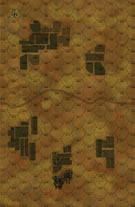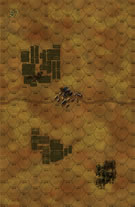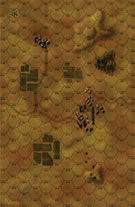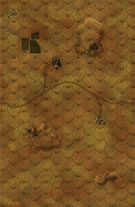|
Swept Aside South Flank #6 |
||
|---|---|---|
| (Attacker) Germany | vs | Soviet Union (Defender) |
| Formations Involved | ||
|---|---|---|
| Germany |  |
2nd SS "Das Reich" Division |
| Soviet Union |  |
14th Antitank Brigade |
| Soviet Union |  |
22nd Guards Tank Brigade |
| Soviet Union |  |
51st Guards Rifle Division |
| Soviet Union |  |
5th Guards Tank Corps |

|
| Overall Rating, 6 votes |
|---|
|
3.83
|
| Scenario Rank: 186 of 964 |
| Parent Game | South Flank |
|---|---|
| Historicity | Historical |
| Date | 1943-07-06 |
| Start Time | 09:30 |
| Turn Count | 24 |
| Visibility | Day |
| Counters | 270 |
| Net Morale | 0 |
| Net Initiative | 2 |
| Maps | 4: 36, 37, 38, 39 |
| Layout Dimensions | 86 x 56 cm 34 x 22 in |
| Play Bounty | 196 |
| AAR Bounty | 155 |
| Total Plays | 4 |
| Total AARs | 3 |
| Battle Types |
|---|
| Delaying Action |
| Exit the Battle Area |
| Inflict Enemy Casualties |
| Urban Assault |
| Conditions |
|---|
| Entrenchments |
| Minefields |
| Off-board Artillery |
| Randomly-drawn Aircraft |
| Reinforcements |
| Terrain Mods |
| Scenario Requirements & Playability | |
|---|---|
| South Flank | Base Game |
| Introduction |
|---|
|
By noon of the first day of the German assault, 6th Guards Army was in desperate straits and armor was ordered forward to support them. One of the formations involved was 5th Guards Tank Corps, which deployed their 200 tanks directly in front of II SS Panzer Corps with the intention of attacking the next day. General Katukov wanted the armor dug in and had a heated debate with Comrade Stalin and Marshal Zhukov over the matter. Then Voronezh Front Kommissar N.S. Khrushchev weighed in, and Stavka deferred to the men on the spot. Then, inexplicably, 5th Guards Tank Corps was sent forward to prevent SS Reich Division from occupying Luchki. |
| Conclusion |
|---|
|
SS Reich Division plowed through the best the Guards could throw at them, with little delay. By lunchtime Luchki had fallen, but having no time for lunch the Germans wheeled to the right and advanced on Teterevino. II SS Panzer Corps’ drive was beginning to gain momentum and the Soviet second line of defense appeared to be breached. |
| AFV Rules Pertaining to this Scenario's Order of Battle |
|---|
|
| 5 Errata Items | |
|---|---|

|
All SS 75mm IG guns are direct fire weapons (black), not indirect (white). (Shad
on 2010 Dec 15)
|

|
The reduced direct fire value of the SS HMG is 5-5 in Beyond Normandy and Road to Berlin. (plloyd1010
on 2015 Jul 31)
|

|
The movement shown on the counter is zero (0) but is listed as 8 just like the regular SdKfz 250 APCs. (thomaso827
on 2016 Jul 11)
|

|
Should have direct fire value of 10-5 and an anti-tank value of 4-4. Values on the Kursk South Flank counter are for SPW-251/22. (plloyd1010
on 2015 Feb 17)
|

|
Kommissars never get morale or combat modifiers. Ignore misprints. (Shad
on 2010 Dec 15)
|
| Chain of command | ||||||||||||||
|---|---|---|---|---|---|---|---|---|---|---|---|---|---|---|
When there is a large body of troops to command,the need to maintain a well coordinated chain of command is an imperative. I failed to maintain a chain of command in this scenario by dividing my forces by design, 3 advancing groups left, center and right, by movement advancing quickly too many of those who could take advance postions, allowing slow moving units to battle too early into the contest, and displeasing the gods of war since fog of war dice rolls of at least 16 ended many a turn. With 14 of 24 turns finished and needing at least 3 turns to put my forces together as an attacking force, 7 turns to transverse the remaining field of battle if there was no opposition. I surrendered the field of battle to the enemy. |
||||||||||||||
| 0 Comments |
| What's your Opponent's Morale? | ||||||||||||||
|---|---|---|---|---|---|---|---|---|---|---|---|---|---|---|
The Kursk scenarios leave very little room for making mistakes; if you advance blunderingly, or if you set up clumsily, there's very little you can do to salvage the situation once the bullets start flying. As the defender in this one, I did my best to spread out the majority of my forces across the line of advance, allowing for maximum AT crossfire, on the second set of boards the Germans needed to advance onto. A suicide detachment was left in the town closest to the German lines. (These guys died to a man-about 16 steps, and only caused 1 step loss for the Germans!) And another rather large battlegroup was massed out of sight in the far field on board 36. I used minefield counters to seal off any approach on the outer flank of the big hill (four German infantry were caught up and shelled mercilessly in these minefields), and the other minefields, mostly dummies, were put on the road outside the town that would inevitably fall to the Germans. This little trick caused the Germans to swing wide of the town or go through it. The Germans came at the Russians en masse on the flank opposite the fallen Russian town, but the forces that came through the town never really got their act togther after taking the town. The Russians managed to survive the German advance and even were able to counterattack in several assaults that nearly evened up the step loss count (Russians had lost 26; the Germans 22 or 24 by the time the German player conceded.) The Germans were losing their infantry steps at a prodigious rate... and the Germans seemed to be constantly trying to get into position for the following turn, not the current one. This was further exacerbated by the fact that EVERY turn ended with a fog of war roll of 16+! By turn 14 the German player was convinced the game was lost and declared a Russian victory. I wasn't so sure of this. My line was thin- the only place I really had depth to my defense was in the field on board 36 where counterassaults were taking their toll on the Germans. If those Tigers had gotten into action, even my dug in T34's on the hill would have been mincemeat. It turned out that in this playing, it was more important to break the opponent than to break his forces. |
||||||||||||||
| 0 Comments |
| Doin' the Wave |
|---|
|
Trips to the beach as a kid were almost always defined by the sand castle. No matter where we went the goal was to build a castle at the very edge of high tide, where the waves would come up to the footings of the castle but never sweep it away. More often than not, I was unable to adequately identify the tide line and watched in incomprehsion as the product of my labor was swept back into the sea, with what seemed to be sinister laughter as a soundtrack. No doubt my Soviet tankers from 5th Guards Tanks Corps had similar experiences. If they haven't they now know what it is like. The wave of SS armor simply was too strong and the high tide line was well off the board in this case. The Soviets set up in three lines, forcing the SS through messy terrain in two separate situations, with the idea of forcing the Nazi tanks into a killing zone in the middle of the boards, perfectly set up for crossfire, etc. In essence the Soviets were willing to tank a chance on heavy losses in order to keep the Germans on the board. The two large reinforcing groups were to be used to set up successive tank traps on the rear areas based on where the Germans made their effort. The Nazis, however, looked at the setup and decided that to engage in a broad sense would be a mistake. They chose instead to throw their effort to the west of the board, capturing Luchki but forsaking the capture of Teterevino (the large town in the northeast of the playing area. To this end the armor was massed and what we saw was more or less a recreation of Murat's charge at Eylau. There was a little more to it than that as the Germans mounted a battalion on SPWs to provide support deeper into the Soviet positions which came to be very valuable in the later stages of the fight. The failure of the Soviet position wasn't, however, that it didn't cause losses to the German tanks. Indeed, there were 20 step losses, aided by the large number of Pz IIIjs with a "4" armor factor and a company or so of Pz 747s (captured T-34As) with a similarly vulnerable "4" armor factor. What really ended the Soviet chance to win this one was the fact that all those arriving tanks eventually had to fire in order to stop the advancing German tanks. In doing so, they were spotted by the Tigers who shredded the final lines of Soviet tanks permitting the motorcycle troops, the mounted battalion and a large force of Pz IVs to ultimately exit the field thus ruining the Soviet goal of keeping less then 30 step values from exiting. Indeed this was accomplished by the Germans during the 22nd turn, in essence with time to spare. By this time the Soviets were reduced to trying to assault armor with soft targets which were then hammered with artillery leading to a shattered Soviet on board force and a substantial German force off board - a major German victory, despite the Soviets continuing to hold Teterevino. This is a very, very good scenario and exciting to play. The only reason that I didn't give it a "5" is that it seems very difficult for the Soviet player to win. My Germans were in position for a major victory even before they started exiting units. Once they did I believe that the victory was by well over 70 points. Yet it was a great deal of fun so I'm not going to downgrade it too much. Those ones that I give a "5" are typically those that are just a much fun as this one to play but with a greater degree of tension in the play based on the victory conditions. So I give it a "4" for the fun. This is a great one for solo or face to face play. I would not think that it is well suited for PBEM since there are a TON of activations necessary. |
| 0 Comments |

 KurS005
KurS005 





















































